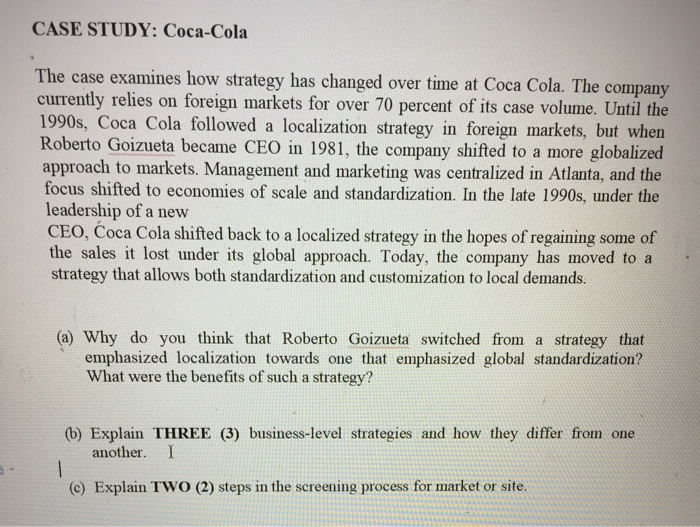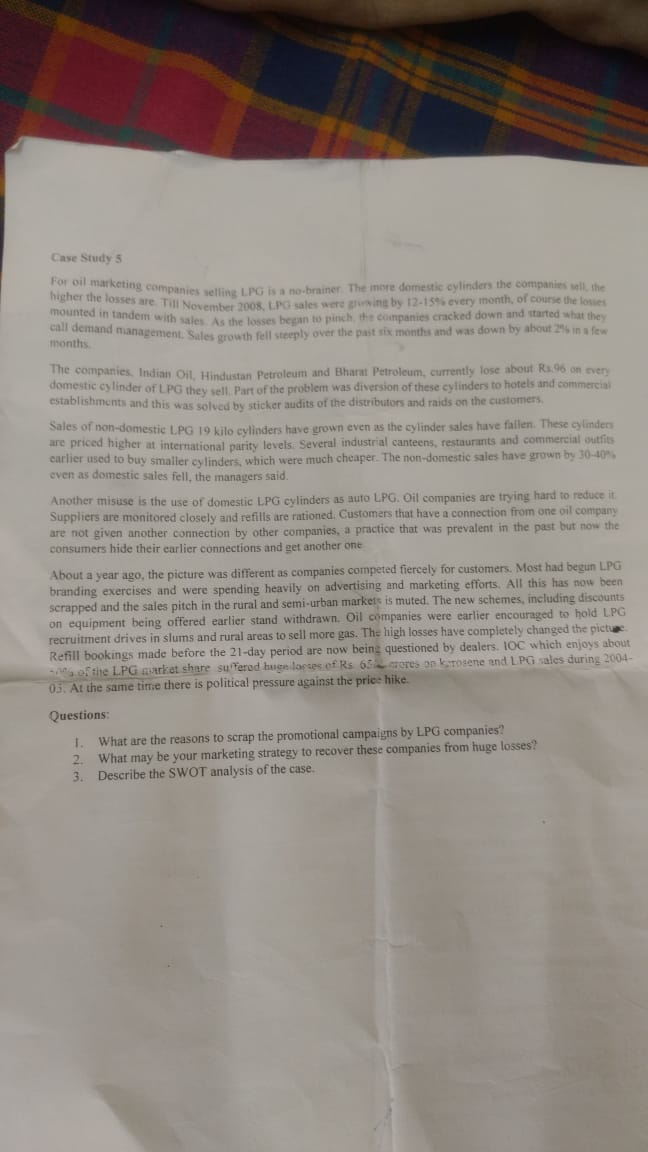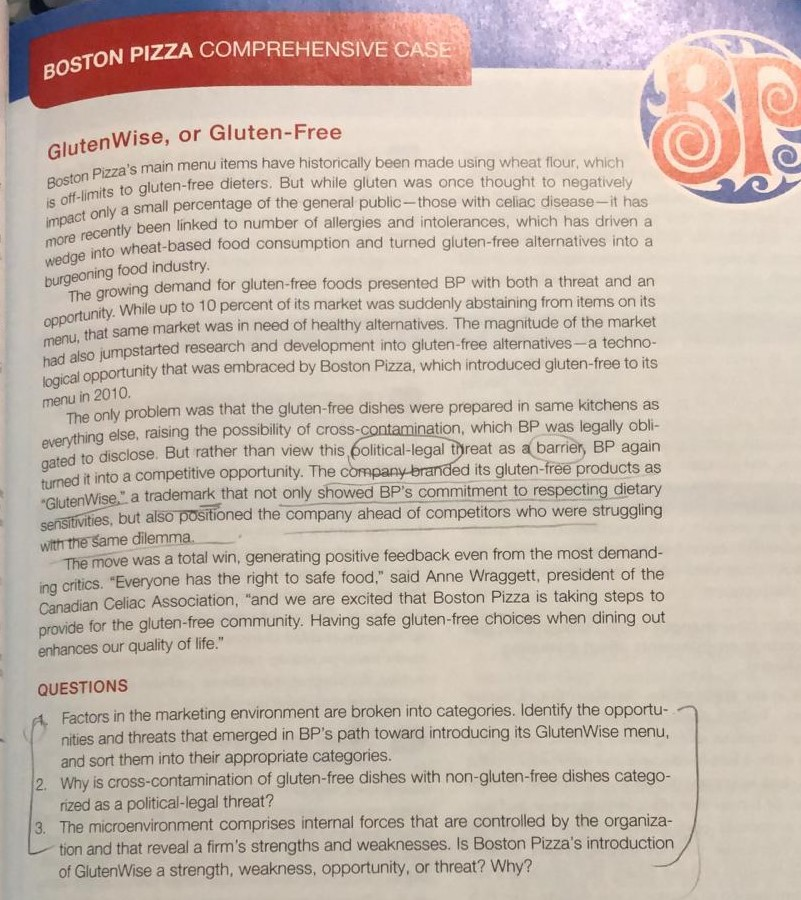.
Read the case study and answer " you make the call " questions
CASE STUDY: Coca-Cola The case examines how strategy has changed over time at Coca Cola. The company currently relies on foreign markets for over 70 percent of its case volume. Until the 1990s, Coca Cola followed a localization strategy in foreign markets, but when Roberto Goizueta became CEO in 1981, the company shifted to a more globalized approach to markets. Management and marketing was centralized in Atlanta, and the focus shifted to economies of scale and standardization. In the late 1990s, under the leadership of a new CEO, Coca Cola shifted back to a localized strategy in the hopes of regaining some of the sales it lost under its global approach. Today, the company has moved to a strategy that allows both standardization and customization to local demands. (a) Why do you think that Roberto Goizueta switched from a strategy that emphasized localization towards one that emphasized global standardization? What were the benefits of such a strategy? (b) Explain THREE (3) business-level strategies and how they differ from one another. I (c) Explain TWO (2) steps in the screening process for market or site.Marketing in Action Case Real Choices at Disney What happens when you are no longer "the Happiest Place The unknown is how consumers will respond to this new on Earth"? The Walt Disney Company doesn't want to find pricing strategy long term. Will they see it as a more equitable out and is "reimagining" its pricing strategy. Responding to system in which you pay more if you want to visit Disney at the the ever-increasing demand for theme park tickets, especially "best" times to travel and pay less if you can vacation at " off" at peak times, Disney has implemented "demand-based pric- times. Of course, consumers may perceive the new strategy ing" at both Walt Disney World in Florida and Disneyland in as a pricing gimmick to gouge consumers during heavy travel California. times to increase Disney profits. Airlines and hotels have used demand-based pricing for Certainly, demand-pricing tactics airlines employ are not years by charging higher prices during summer vacation sea- thought of kindly and have contributed to negative consumer son and around holidays when demand for flights and hotel attitudes toward the airlines. Although Disney stresses that accommodations is highest. Similarly, demand-based pricing it is using the new demand-based pricing to more efficiently has been in use by Disney competitor, Universal Studios, and manage its customer experience, it should be obvious that this other theme park operators in the United States. The idea is to policy can also lead to greater profits. Even more important. redistribute customer demand by lowering prices during times how will consumers think of Disney and its theme parks long with less demand to encourage more sales and increase prices term? Will Disney still be the happiest place in the world? at times when demand is higher to encourage customers to switch some of their visits to lower-priced times. Visitors to Disneyland were previously charged a single- You Make the Call day ticket price of $99.00. Under demand-based pricing, 10-36. What is the decision facing Disney? there are three prices. "Value" tickets for Mondays through 10-37. What factors are important in understanding this Thursdays during weeks when children are in school are only decision situation? $95, a reduction of $4.00. "Regular" tickets for most week- 10-38. What are the alternatives? ends and summer months are $105. "Peak" tickets for visitors 10-39. What decision(s) do you recommend? during December, spring break weeks, and July weekends 10-40. What are some ways to implement your recommen are highest at $119. For Orlando's Disney World, the pricing dation? is similar but more complex as a result of having four differ- ent parks at the site. The new demand-based pricing is only for single-day tickets and does not affect the price of annual passes or multiday tickets, which most families buy when they travel to Disney.Case Study 5 For oil marketing companies selling LPG is a no-brainer. The more domestic cylinders the companies well, the higher the losses are. Till November zoos Er ember 2008, LPG-sales were growing by 12-15% every month, of course the losses mounted in tandem with sales. As the losses began to pinch, the companies cracked down and started what they call demand management. s months ent. Sales growth fell steeply over the past six months and was down by about 2% in a few The companies, Indian Oil, Hindustan Petroleum and Bharat Petroleum, currently lose about Rs.96 on every domestic cylinder of LPG they sell, Part of the problem was diversion of these cylinders to hotels and commercial establishments and this was solved by sticker audits of the distributors and raids on the customers, Sales of non-domestic LPG 19 kilo cylinders have grown even as the cylinder sales have fallen. These cylinder are priced higher at international parity levels: Several industrial canteens, restaurants and commercial outfits earlier used to buy smaller cylinders, which were much cheaper. The non-domestic sales have grown by 30-10% even as domestic sales fell, the managers said. Another misuse is the use of domestic LPG cylinders as auto LPG. Oil companies are trying hard to reduce it. Suppliers are monitored closely and refills are rationed, Customers that have a connection from one oil company are not given another connection by other companies, a practice that was prevalent in the past but now the consumers hide their earlier connections and get another one About a year ago, the picture was different as companies competed fiercely for customers. Most had begun LPG branding exercises and were spending heavily on advertising and marketing efforts. All this has now been scrapped and the sales pitch in the rural and semi-urban markets is muted. The new schemes, including discounts on equipment being offered earlier stand withdrawn, Oil companies were earlier encouraged to hold LPG recruitment drives in slums and rural areas to sell more gas. The high losses have completely changed the picture Refill bookings made before the 21-day period are now being questioned by dealers. IOC which enjoys about My of the LPG market share suffered huge losses of Rs 6524 crores on kerosene and LPG sales during 2004- 03. At the same time there is political pressure against the price hike. Questions: I. What are the reasons to scrap the promotional campaigns by LPG companies? 2. What may be your marketing strategy to recover these companies from huge losses? 3. Describe the SWOT analysis of the case.BOSTON PIZZA COMPREHENSIVE CASE GlutenWise, or Gluten-Free Boston Pizza's main menu items have historically been made using wheat flour, which is off-limits to gluten-free dieters. But while gluten was once thought to negatively impact only a small percentage of the general public-those with celiac disease- it has more recently been linked to number of allergies and intolerances, which has driven a wedge into wheat-based food consumption and turned gluten-free alternatives into a burgeoning food industry. The growing demand for gluten-free foods presented BP with both a threat and an opportunity. While up to 10 percent of its market was suddenly abstaining from items on its menu, that same market was in need of healthy alternatives. The magnitude of the market had also jumpstarted research and development into gluten-free alternatives-a techno- logical opportunity that was embraced by Boston Pizza, which introduced gluten-free to its menu in 2010. The only problem was that the gluten-free dishes were prepared in same kitchens as everything else, raising the possibility of cross-contamination, which BP was legally obli- gated to disclose. But rather than view this political-legal threat as a barrier, BP again turned it into a competitive opportunity. The company branded its gluten-free products as "GlutenWise," a trademark that not only showed BP's commitment to respecting dietary sensitivities, but also positioned the company ahead of competitors who were struggling with the same dilemma. The move was a total win, generating positive feedback even from the most demand- ing critics. "Everyone has the right to safe food," said Anne Wraggett, president of the Canadian Celiac Association, "and we are excited that Boston Pizza is taking steps to provide for the gluten-free community. Having safe gluten-free choices when dining out enhances our quality of life." QUESTIONS Factors in the marketing environment are broken into categories. Identify the opportu nities and threats that emerged in BP's path toward introducing its GlutenWise menu, and sort them into their appropriate categories. 2. Why is cross-contamination of gluten-free dishes with non-gluten-free dishes catego- rized as a political-legal threat? 3. The microenvironment comprises internal forces that are controlled by the organiza- tion and that reveal a firm's strengths and weaknesses. Is Boston Pizza's introduction of GlutenWise a strength, weakness, opportunity, or threat? Why










